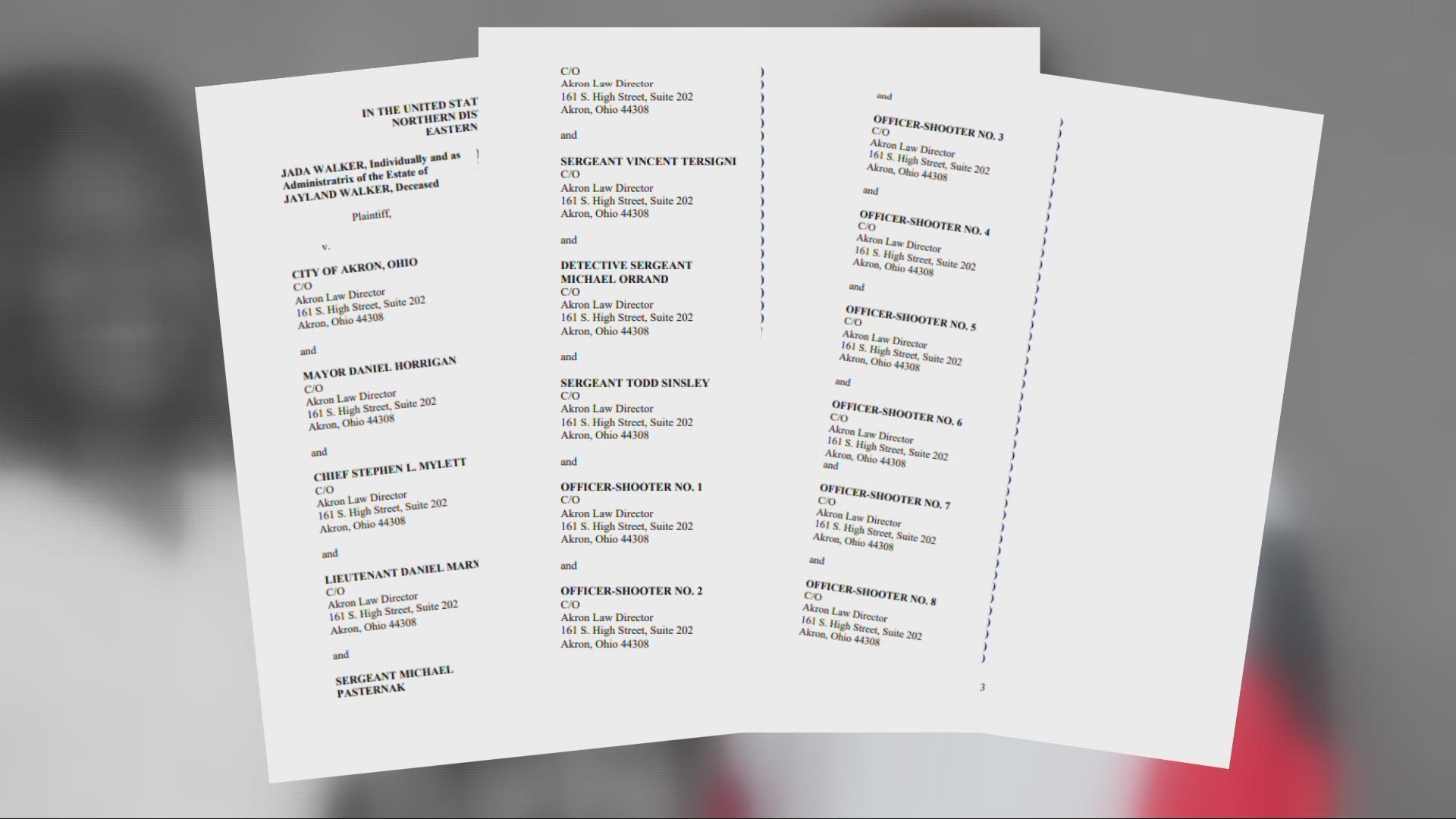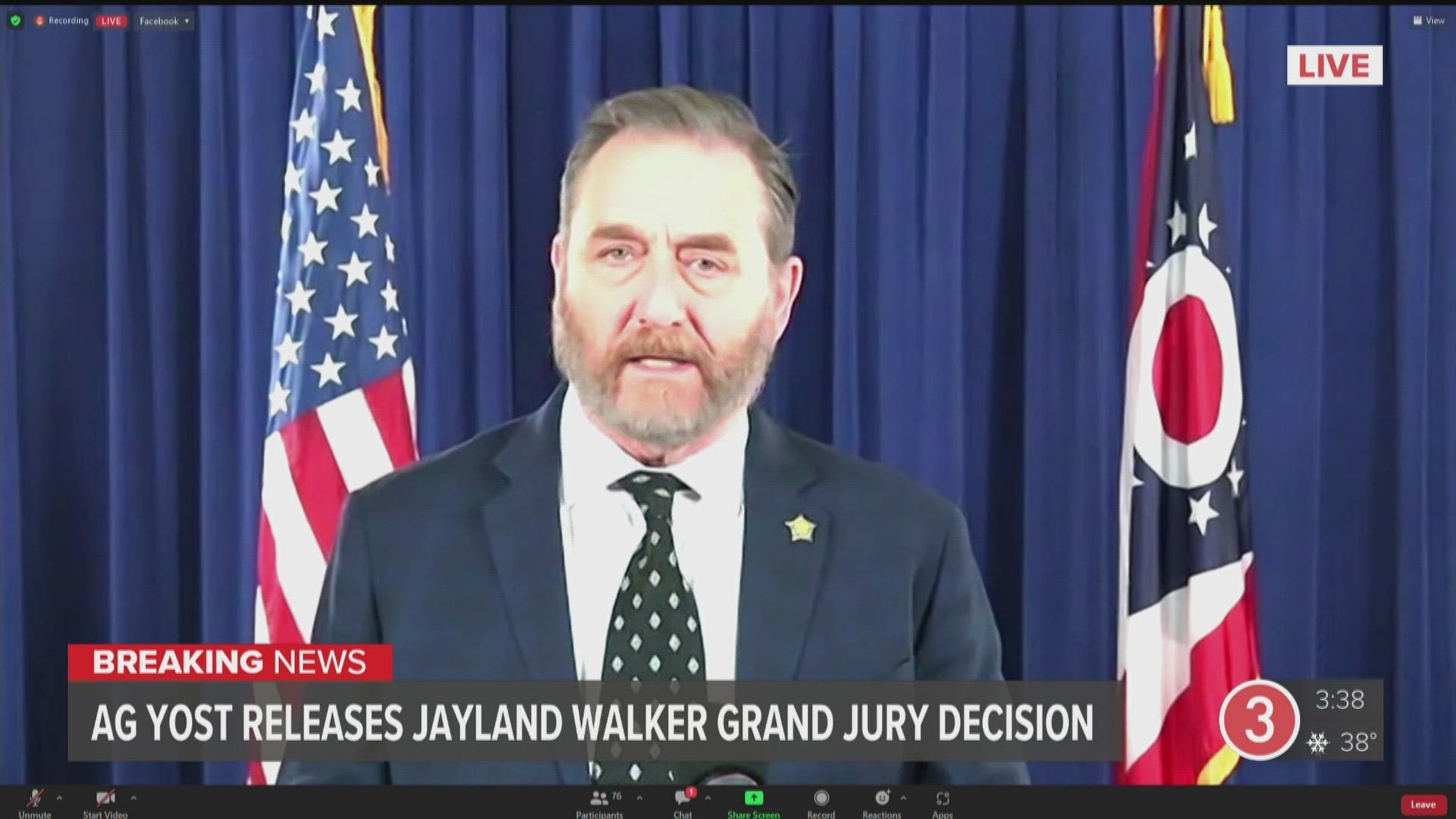AKRON, Ohio — Nearly one year after Jayland Walker was killed by Akron police amid an overnight chase, his family has now filed a lawsuit in Ohio federal court claiming the officers “used excessive force.”
The lawsuit, which was announced Friday, is against the city of Akron and the eight officers involved in the shooting. The lawsuit also names Akron Mayor Dan Horrigan and Akron Police Chief Steve Mylett as defendants.
“The case, filed in the U.S. District Court for the Northern District of Ohio, seeks at least $45 million in damages, $1 million for each bullet that struck Jayland Walker,” according to a press release.
The Walker family legal team held a press conference to discuss the lawsuit on Friday afternoon. You can watch it again below:
Attorneys Bobby DiCello and Kenneth Abbarno were joined by Walker’s mother and sister for the press conference, which was held inside of the First Congregational Church of Akron on East Market Street. Pastor Robert DeJournett also spoke.
“A year has passed since Jayland Walker was violently ripped away from his family, and still they have not been able to achieve justice and accountability,” DiCello said in a press release. “The City of Akron and its police department have been given every opportunity to participate in a fair process to address what went wrong last June 27. At every turn, they protect their officers from accountability. Now we must engage the judicial process to accomplish what the city was unwilling to do -- hold these officers accountable for their actions. We will use the judicial system to ensure that Jayland Walker and his family get the justice they deserve.”
After a months-long investigation into Walker’s shooting death, Ohio Attorney General Dave Yost announced in mid April that no criminal charges would be filed against any of the eight officers involved.
"Legal justification does not change the terrible, permanent damage of Jayland Walker's death," Yost said upon revealing the grand jury’s “no bill” decision on April 17. "I grieve the loss of this promising young life, although I recognize that no words of mine can offer much comfort to his family."
CASE DETAILS
The incident began around 12:30 a.m. on the morning of June 27, when Walker led officers on a pursuit along multiple streets. State prosecutors confirmed police had been attempting to pull Walker over for a broken tail light, and that the same vehicle had been involved in a similar chase the previous night in New Franklin.
"There is no doubt that [Walker] did, in fact, shoot at police officers," Yost declared when discussing results of the investigation.
The vehicle slowed down near East Wilbeth Road and Clairmont Avenue, and Walker eventually got out of the car in the parking lot of Bridgestone while wearing a ski mask. Yost said Walker ignored "multiple commands by officers to show his hands and to stop," and that officers attempted to use a Taser before Walker "reached for his waistband in what several officers described as a cross draw motion, planted his foot and turned toward the officers while raising his hand."
"The officers did not know at the time Mr. Walker had left his recently purchased gun in his car," the AG said, adding that his earlier gunshot could be classified as a "deadly threat" that would allow officers to use deadly force to defend their own lives.
The eight officers, who have not been identified, were placed on administrative leave in accordance with department protocol before returning to work and assigned to administrative duty months later in October.
BODYCAM VIDEO & MEDICAL EXAMINER REPORT
Walker's death led to protests across Akron following the release of body camera video of the shooting.
The Summit County Medical Examiner's Office later released a report saying Walker had nearly four dozen entrance/graze wounds as a result of the shooting, which were listed as follows:
- 17 gunshot wounds injured the pelvis and upper legs, causing internal injury to the right iliac artery (a major artery going to the leg), the bladder and fractures to the pelvis and both upper leg bones (femurs).
- 15 gunshot wounds injured the torso, and caused internal injury to his heart, lungs, liver, spleen, left kidney, intestines and multiple ribs.
- One bullet struck the face and fractured the jaw.
- Eight gunshot wounds injured the arms and right hand.
- Five gunshot wounds injured the knees, right lower leg and right foot.
Toxicology screenings were negative for drugs and alcohol, and Walker had no prior criminal history. Officials also listed the following "evidence of medical intervention" on Walker's body to determine if officers attempted to help him after being shot:
- Tourniquets on his legs and left arm.
- Gauze dressings to his chest and abdominal wounds.
- Adhesive seals over two chest wounds.
- Defibrillator pads on his chest.
TODAY'S LAWSUIT
3News has obtained a copy of the complaint filed in the United States District Court for the Northern District of Ohio. Besides Horrigan and Mylett, it also specifically names five other higher-ups from the Akron Police Department:
- Lieutenant Daniel Marx
- Sergeant Michael Pasternak
- Sergeant Vincent Tersigni
- Detective Sergeant Michael Orrand
- Sergeant Todd Sinsley
Notably, however, the eight officers involved in Walker's death are not named, only being referred to as "Officer-shooter" No. 1-8. Walker family attorneys have filed to keep the names private, for now, but will leave the final decision up to the court. Ten more anonymous "Jon Does" are also listed.
The plaintiffs argue there never should have been a police pursuit against Jayland Walker to begin with, saying Walker's decision to circle back around to an intersection where police saw him for a second time with an alleged cracked taillight was not sufficient reason for them to begin following him.
In regard to Walker firing his weapon, the lawsuit also claims the bullet was never "directed at" officers during the pursuit, a diversion from the AG's findings. It additionally criticized the first officer who called in a "Signal 21" over the radio requesting help, claiming he and his partner never saw "any threatening gesture, alleged gunshot, or other conduct directed at them" or even "a muzzle flash in their direction."
DiCello says this case is intended to go beyond Walker's death, believing it uncovers institutional problems within the Akron Police Department.
"When you measure the things they said about Jayland, you'll know who the real monster is in this case, and it's not Jayland Walker," DiCello told reporters. "I wake up every morning and I think about Jayland and his family, and how they've been ruined by hate. I work with this team every single day because they work against hate."
That culture of "hate," according to DiCello, goes all the way back to 1998, when members of the department published a satirical newsletter called "Signal 44 (PBS to Air a New Wildlife Documentary)." The newsletter allegedly compared city citizens to animals and "contained violent and overtly racist content," leading to an internal affairs inquiry.
"It's shocking that not only was no officer fired for his involvement in the Signal 44 newsletter, nobody was even disciplined and many of the officers who had no issue with the violent and racist content were allowed to advance to the leadership positions they hold today," attorney Ken Abbarno stated.
Among those involved, Clay Cozart was a patrol officer at the time and apparently expressed no regrets about his name being on the newsletter, telling investigators the controversy was "unfair." Cozart is currently a detective and also serves as president of Akron's police union.
3News has reached out to both the Akron Police Department as well as Mayor Dan Horrigan's office for comment and is waiting to hear back.


